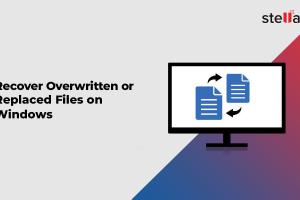3 Simple Ways to Recover Overwritten Files on Your Computer

-
Quick Links:
- Introduction
- Understanding Overwritten Files
- Method 1: Using File Recovery Software
- Method 2: File History and Versioning
- Method 3: Backup Solutions
- Case Study: Real-World Recovery Scenarios
- Expert Insights
- Conclusion
- FAQs
Introduction
In an age dominated by digital files, losing important data can be a nightmare for any computer user. When files are overwritten, the original data is often thought to be lost forever. However, there are several methods to recover overwritten files. In this comprehensive guide, we will explore three simple yet effective ways to retrieve your lost data.
Understanding Overwritten Files
Overwritten files occur when a file is saved with the same name and location as an existing file, effectively replacing the original data. This can happen due to accidental saves, file transfers, or software updates. Understanding how this process works is crucial for recovery.
When a file is overwritten, the data isn't immediately removed from the hard drive. Instead, the space it occupied is marked as available for new data. This means that recovery is still possible until that space is used by new files.
Method 1: Using File Recovery Software
File recovery software is one of the most popular methods to retrieve overwritten files. These tools can scan your hard drive for recoverable data and restore it to its original state. Here’s how to do it:
Step 1: Choose the Right Software
There are numerous file recovery tools available, including:
- Recuva
- EaseUS Data Recovery Wizard
- Disk Drill
- Stellar Data Recovery
Choose software that fits your needs based on user reviews and functionality.
Step 2: Install the Software
Download and install the chosen software on a different drive than the one containing the overwritten file to prevent further data loss.
Step 3: Scan for Overwritten Files
Run the software and select the drive where the file was originally located. Initiate a full scan.
Step 4: Recover Your Files
Once the scan is complete, the software will present a list of recoverable files. Select the files you wish to restore and follow the prompts to recover them.
Method 2: File History and Versioning
If you are using Windows, the File History feature can be a lifesaver. It automatically backs up files stored in certain folders. Here’s how to utilize it:
Step 1: Access File History
Navigate to Control Panel > System and Security > File History. Ensure that it is turned on.
Step 2: Restore Previous Versions
Locate the folder that contained the overwritten file. Right-click on the folder and select Restore previous versions.
Step 3: Choose a Version
A list of available versions will appear. Choose the version you want to restore and click Restore.
Method 3: Backup Solutions
Regularly backing up your files can shield you from the agony of data loss. Here are some effective backup solutions:
Cloud Storage Solutions
Using cloud services like Google Drive, Dropbox, or OneDrive ensures that your files are backed up in real-time. Many of these services allow version history, making it easy to revert to earlier versions of files.
Local Backups
External hard drives or NAS (Network Attached Storage) systems are excellent for local backups. Software like Acronis or Macrium Reflect can automate the backup process.
Case Study: Real-World Recovery Scenarios
Consider the case of a graphic designer who accidentally overwrote a crucial project file. Using Recuva, she was able to scan her drive and successfully recover the overwritten file within minutes. This not only saved her project but also highlighted the importance of regularly backing up her work.
Expert Insights
Data recovery experts advise that the best way to prevent data loss is through proactive measures. Regular backups, using cloud services for critical files, and employing recovery software can significantly mitigate risks. Additionally, they recommend avoiding the use of the affected drive until recovery efforts are complete.
Conclusion
Recovering overwritten files is possible and can be done using various methods. Whether through specialized recovery software, utilizing built-in backup features like File History, or maintaining regular backups, you can protect your data effectively. Remember, the key to successful recovery lies in acting quickly before new data overwrites the lost files.
FAQs
1. Can all overwritten files be recovered?
No, recovery is not guaranteed. The chances decrease if new data has been written to the same space.
2. How does file recovery software work?
File recovery software scans the hard drive for remnants of deleted files and attempts to restore them.
3. What is the best file recovery software?
Popular options include Recuva, EaseUS Data Recovery Wizard, and Disk Drill, among others.
4. Is it safe to use recovery software?
Generally, yes. Just ensure you download from reputable sources to avoid malware.
5. How often should I back up my files?
It’s wise to back up files regularly, ideally daily or weekly, depending on how often you make changes.
6. What is the difference between cloud and local backups?
Cloud backups store data online, while local backups are stored on physical devices like external hard drives.
7. Can I recover files if I didn't have backups?
Yes, using recovery software may help, but success is not guaranteed.
8. How long does file recovery take?
It can take anywhere from a few minutes to several hours, depending on the size of the drive and the recovery method used.
9. What should I do immediately after realizing a file is overwritten?
Avoid using the affected drive to minimize the risk of overwriting more data.
10. Are there any risks involved in using recovery software?
While generally safe, using untrustworthy software can lead to further data loss or malware infections.